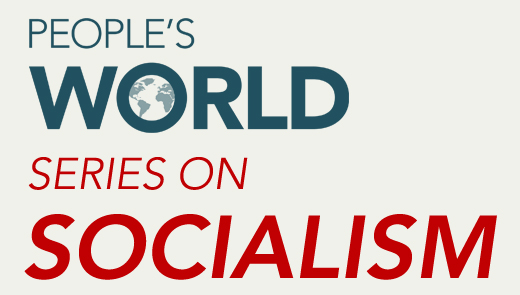
People’s World Series on Socialism
Everyone seems to be talking about socialism these days, but what does it mean? That was the question asked by Susan Webb in one of our most popular and widely-shared recent articles. Millions of Americans are considering alternatives to a system run by and for the 1 percent. They are taking an interest in socialism, a word that has meant a great many things to activists, trade unionists, politicians, and clergy around the world over the last century and a half. The article below is one of a series on socialism, what it can mean for Americans in the 21st century, and how we might get there. Other articles in the series can be found here.
In his November 2015 speech on the idea of democratic socialism, Senator Bernie Sanders linked government policies with his definition of that concept at least 11 times. He listed a Medicare-for-all program, legal protections for workers (e.g. improved minimum wage at $15), free public university education, the government’s responsibility to create a full-employment economy, serious campaign finance reform, voting rights protections, and a fair and progressive tax system in his definition.
These demands are essential to a just society, both in their specifics and in the general concept. They are vital to improving the situation of the working class and strengthening its ability to participate more fully in the economic and political life of the country.
Cycles of investment and innovation
More needs to be said about the connection between those policies and socialism, however. In his book, Postcapitalism, economics journalist Paul Mason (following Marx) argues that capitalism moves through cycles of investment and innovation, high profits with growth and prosperity, falling rates of profits and crisis, and stagnation. The latter events are followed by worker protest, state intervention, global crises, and then finally a major adaption in which new technology, new business models, new social relations, and new finance capital is harnessed to the next cycle. It is important to think of this theory of cycles not as a rigid sequential model, but rather as an abstraction that helps to explain the development and adaptability of capitalism. It explains why capitalism in 2015 isn’t identical to capitalism in 1815.
If this cycle theory holds, the 2008 recession signaled the crisis stage of capitalism followed by massive state intervention in the operations of banks and other major multinational finance-driven industries (like auto) along with “stimulus packages” promoting job growth. By contrast with state intervention in the 1930s and 1940s, the current moment is missing in significant ways the shift in the class balance of forces that the Great Depression introduced. In the 1930s, the limited state alliance with the labor movement resulted in about 35 percent of all U.S. workers in labor unions by the mid-1950s, a minimum wage in today’s dollars that was close to $11 per hour, a new system of retirement savings, and more. Even radical economists say that those reforms pioneered “the golden age of capitalism.”
Indeed, that particular cycle of capitalism saw a new Keynesian ideological regime that would last until the logic of neoliberalism-a logic of the unfettered movement of capital, suppressed wages, privatization of or elimination of public services, and financialization-held sway with the election of Reagan in 1980. By way of an historical example, I want to briefly tell the story of William M. Glenn, a Grand Rapids, Michigan resident who played no small role in building more democratic socialism in that city.
In 1977, Glenn, the African American founder and leader of a community advocacy organization called Young and Old United, applied to the Department of Community Development for a $200,000 federal grant to build low-income housing for seniors in downtown Grand Rapids, Michigan. Glenn argued that racially-integrated housing located near the cultural life of the city was vital for seniors who lived primarily on their Social Security or disability income. He cited a distinct lack of care by private owners as well as government agencies for the buildings already set aside for poor senior citizens.
Glenn, who was born in 1903, had participated in the struggle to desegregate the city’s public facilities, had been a leader in the UAW in the 1940s and 1950s, and had been harassed by federal and state authorities for his membership in the Communist Party in the 1950s. Now, he refused to retire peacefully. Since the 1960s, he had worked to advocate for the rights and needs of seniors, especially on the issue of providing quality, affordable housing. One document in his archived papers held at the Grand Rapids Public Library notes that his leadership in the struggle for affordable housing led to the creation of almost 1000 units of new low-income housing in the city since 1966.
Glenn’s activism saw him appointed to the Mayor’s Committee on Central Area Housing in the early 1970s. Discussions in the committee, which included prominent business, labor, and community leaders, centered on how to mobilize resources from multiple sources to build new low-income housing. After the passage of the Housing and Community Development Act of 1974, Glenn took the opportunity to leverage newly available federal dollars for low-income housing for seniors. By 1977, after a brief period of foot-dragging by the state, authorities were prepared to okay Glenn’s project. The following year, the Ransom Avenue Development Corporation was created as a non-profit organization that applied for and won a federal grant. The contract between it and a local general contractor shows the entire project cost over $4 million. The facility today admits seniors over 62 years of age eligible for federal housing subsidies.
The project flowed from attempts at improved municipal planning, community need, and tireless activism rather than financial speculation or fabricated consumer demand (like most capitalist investments). It produced both profits for builders and social good for city residents. Glenn understood this one action to be part of a larger struggle for affordable housing. His papers include numerous organizational documents, working papers, and surveys and studies of racially-motivated redlining in cities across the state of Michigan, of ongoing activism by organizations to expand housing options, and analysis of how federal dollars for housing projects had been distributed unfairly to advantage already privileged communities in the city of Grand Rapids and elsewhere.
In addition to those positive results, the kinds of reforms Glenn fought for played a significant role in introducing the next cycle of capitalism: the shift from crisis and stagnation to a return to innovation and growth and prosperity. Marx observed this phenomenon in the 1860s and Paul Mason has observed it again recently. Indeed, if Mason’s interpretation of Marx’s cycles of capitalism concept are correct, a realistic reading of Glenn’s work might suggest how it (in combination with broader social forces operating in the housing and finance sectors locally and nationally) harnessed political activism to the project of the freeing-up of capital investments that helped open the latest stage of neoliberal capitalism.
My point is not that Glenn should have spent his retired years in less rigorous pursuits in order to watch capitalism collapse. Instead, I argue that those social democratic reforms both aid the working class in its struggle for survival and open the possibility for its empowerment. For example, Glenn wasn’t a trained expert on law, economics, or the details of corporate or government bureaucratic machinery that operate in the housing sector. He had to learn all of that through struggle and experience-perhaps from his youth in legal battles against segregation, his leadership in the labor movement, or the day-to-day work of building a just housing movement. That body of knowledge, unfortunately, may have passed with him.
Struggle opens new possibilities
To this mix of democratic socialist reform, both Marx and Mason add that the potential for innovation and the working-class struggle for democracy, power, and rights create new opportunities for much deeper transformations than simply grinding it out at the same dysfunctional wheel. Instead of living with the cycle and always fighting effects, Marx urged in an 1865 speech to the International Workingmen’s Association, the working-class movement had to learn to fight and transform systemic causes.
In his study of the shift from feudalism to capitalism in England, Marx documented the emergence of new technologies, the rise of a new class with investment-hungry wealth that had grown outside of the aristocracy, increasing global intrigues and expropriations, along with the break-down of traditional modes of work and social relationships (like serfdom) that enabled the formation of a new system-capitalism. Essentially, Marx argues in Capital that small quantitative social changes added up to force a qualitative systemic transformation.
If that mathematical metaphor is to hold for capitalism in the present, what are the quantitative changes necessary to create that qualitative transformation? The example of William Glenn’s initiative to leverage public resources to build low-income senior housing is a model of the democratic socialist concept advanced by Sen. Sanders. Wedded to that, however, might be concepts and patterns built into neoliberalism already.
New information-based technology has altered basic work patterns in the neoliberal era. Increasingly automated production and telecommuting are business strategies designed to increase production and reduce labor costs-to improve the margin of profit. They link ideologically with concepts like “maker culture” or “design thinking,” which are hot trends in some university departments that are increasingly concerned about whether or not traditional humanities degrees prepare students for the 21st century professional workplace. A knowledge-based economy demands workers be flexible and adaptable, university promotional materials now say.
But, Mason notes, this situation produces a contradiction not easily overcome. Value (and thus profit) can only be produced by labor. Mason speculates, “If a machine lasts forever, it transfers a near-zero amount of labor value to the product, from here to eternity, and the value of each product is thus reduced.” In addition to the rise of the machines, the new period is increasingly reliant on information and knowledge as a factor of production. With this in mind, Mason observes another vital contradiction. Capitalist economics demands the use of intellectual property rights to protect an individual capitalist’s proprietary knowledge from being stolen. But in this modern era of information saturation (think of how Napster, though short-lived, permanently transformed the music industry), intellectual property rights has proven to be a severe constraint on innovation, culture, and standards of living. Think of the public reaction to “Pharma Bro” Martin Shkreli’s decision to raise the price of Daraprim over 5000 percent; further still, think about whether or not there would have been a similar reaction in a society without social media.
Open source knowledge production on a small scale (think of how the things Glenn learned to do in his lifetime might have been preserved in digital form) or on a large scale (think of the kind of technological infrastructure needed to build a movement of fair housing social movements) very well could alter how we think about socialist concepts like economic planning or collaborative production. The impulse for large-scale, government-led democratic socialist reforms linked to an educational, cultural, and productive shift in innovation could produce the quantitative changes to qualitative transformation Marx counted on. What seems to be missing from a message like Sen. Sanders’, though, are outlines for those institutional and non-institutional spaces where individual and collective innovation and creativity aren’t cynically harnessed for profit margins, but rather for big, dynamic social changes.
Joel Wendland is a professor in the Liberal Studies Department at Grand Valley State University in Michigan. For many years, he was the editor of Political Affairs magazine and is the author of the recent book, The Collectivity of Life: Spaces of Social Mobility and the Individualism Myth.










